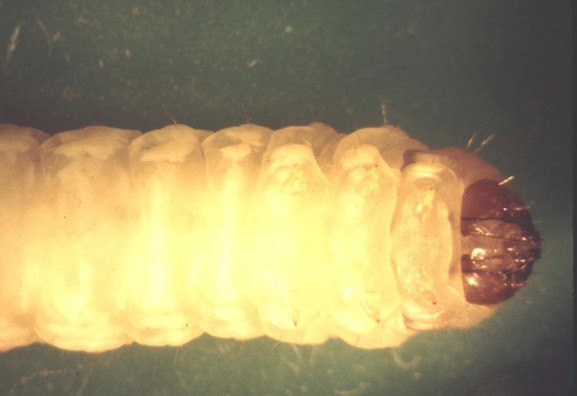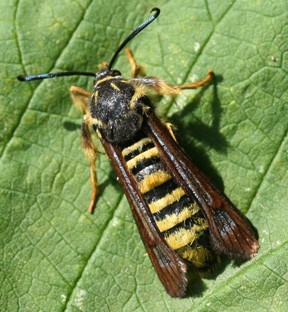Adult raspberry crown borers are striking black and yellow moths, 10 to 15mm (3/8 to 5/8 inch) long. In some individuals, the yellow is quite bright, while in others it is almost white. They look just like a yellow jacket, and fly during the daytime. Although the name sounds similar to raspberry cane borer, the cane borer is actually a beetle. In general, crown borer does not seem to be too serious a pest in New Hampshire, but occasionally sites can be heavily attacked.
In New Hampshire crown borers fly from about August 10 until September 18. The adult moths lay eggs individually, usually on the underside of the leaves, especially those on the middle or lower sections of the plant. The brown oval eggs are about two mm (roughly 1/16 inch) long and hatch into tiny caterpillars that crawl towards the base of the cane and then bore in. Sometimes the entry point is four to six inches above ground. They bore downwards and feed inside the crown and roots, and sometimes in the lowest three to five inches of the canes. They complete their growth in their second July. Fully grown larvae are stout, about one inch long, cream colored, with three pairs of short dark legs and five pairs of prolegs. The prolegs are sometimes hard to see, but they are there. The larvae of other borers in brambles (red-necked cane borer, raspberry cane borer and cane maggot) do not have legs, and are quite slender. In New England, raspberry crown borers often create swellings near the base of the canes. The swellings may be confused with those caused by rednecked cane borer. You can tell the species by the pattern of damage (ex: is there below ground boring?) and the form of the larvae (legs present?). The boring can reduce the vigor and productivity of the affected plants. We do not have an established threshold (the degree of infestation that makes it worthwhile to apply an insecticide) for this insect.
If you find an adult resting on your brambles, or laying eggs there, expect an attack from the larvae. You can reduce the chances of having problems by eliminating nearby unmanaged raspberries or blackberries.


Commercial growers that have what they think is a significant infestation may wish to apply an insecticide drench in fall after harvest is complete, or in spring before bloom. Bifenture EC, Brigade WSB, Hero, and Sniper 2E are insecticides registered for this purpose in New Hampshire in 2014. The target for this treatment is the larval stage of the borer. Altacor is also registered as a foliar spray directed toward the base of the canes. It should be targeted at the time of egg hatching, so in New Hampshire that is late August to mid-September. The label indicates that it can also be applied in early spring, and requires rain or irrigation to move it to the root zone. I don’t know if there has been success using deep-penetrating species of insect-attacking nematodes, such as Steinernema feltiae, Heterorhabditis bacteriophora or Heterorhabditis megidis. Theoretically it should work, and May would be the likely application time. Backyard growers may have a more difficult time managing a crown borer infestation, compared to commercial growers. There are insecticides registered for this purpose, but most of the effective treatments are available only in commercial-sized packages. In the early 1900’s growers were advised to keep alert for the damage, and pull out and destroy affected crowns. For certified organic growers with significant problems, the only management options seem to be tolerating the attacks, or experimenting with the nematodes.

Stop! Read the label on every pesticide container each time before using the material. Pesticides must be applied only as directed on the label to be in compliance with the law. All pesticides listed in this publication are contingent upon continued registration. Contact the Division of Pesticide Control at (603) 271-3550 to check registration status. Dispose of empty containers safely, according to NH regulations.

Acknowledgements
Thank you to Heather Bryant for reviewing the original manuscript and making helpful suggestions and Mary West for reformatting this fact sheet. All photos are by Alan Eaton. Partial support for this work came from an IPM grant from the National Institute for Food and Agriculture.
Download the resource for the complete fact sheet.
